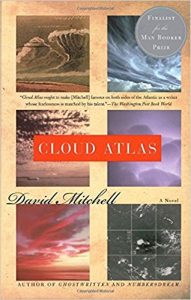
The most notable feature of David Mitchell’s award-winning—and challenging—novel Cloud Atlas is the book’s structure. Made up of six loosely-connected novellas, each in a radically different style and time period, this novel nests the six stories like Russian dolls. The book opens with the story set in the oldest time period, then forty pages later, that story is interrupted to start the next. We work from past to present then future with the uninterrupted sixth story in the middle, and then work our way back out in reverse order, picking up each interrupted story where it left off. (Thankfully only one story is interrupted in the middle of a sentence.)
The six stories by themselves range from not bad to excellent; together they complement each other and add up to something that feels a bit more than the sum of its parts. The critics who call this a masterpiece are right; I’m amazed by the stylistic virtuosity on display.
The overall theme, as I understand it, is the immutability of human nature, with the strong preying on the weak. That sounds like a downer—some of the individual stories are, with one suicide, one threatened execution, and several murders, attempted or succesful—but some of them have positive endings, some human connections are made and trust established, and the first/final story ends on a hopeful note, with the narrator pledging his life to a noble cause.
The connections between the stories are rather tenuous, but each story plays some role in the next: the journal in the first story is read by the second story’s letter writer, his letters are passed on to the journalist in the third, and so on. There are also hints of reincarnation, with a recurring birthmark (a device I found more silly than helpful).
The six stories are:
- The Pacific Journal of Adam Ewing: In the opening story the prey is Ewing himself. An American lawyer traveling from Australia back to the United States in the mid 19th-century, Ewing records his encounter with an abused slave in the Chatham Islands, and his burgeoning friendship with another passenger, Henry Goose. The slave, Autua, stows away aboard ship, and Ewing talks the captain out of tossing the man overboard, a decision that turns out to have been a wise move.
- Letters from Zedelghem: Young bisexual musician Robert Frobisher writes frantic letters to his English lover, Rufus Sixsmith. It’s 1931, in the Netherlands, and Frobisher is working as amanuensis (secretary/copyist) to an established, and dying, older musician, Vyvyan Ayrs. While there, Frobisher begins work on his own magnum opus, Cloud Atlas Sextet. Ayrs and Frobisher prey on each other, with Frobisher having an affair with Ayrs’s wife, and the exhausted Ayrs taking credit for Frobisher’s work.
- Half-Lives: The First Luisa Rey Mystery: This mystery/thriller, set in 1975, follows journalist Luisa Rey’s attempt to expose corporate malfeasance. A nuclear power plant is not safe, and potential whistleblowers are found dead.
- The Ghastly Ordeal of Timothy Cavendish: This comedy, set in the present day, is both funny and cringe-inducing. Cavendish, in his 60’s, keeps asking his brother for money. His exasperated brother sends him to what Cavendish thinks is a hotel, but turns out to be a nightmare of a nursing home for the demented. Unable to leave or get a message to anyone outside, he teams up with other disgruntled residents to escape.
- An Orison of Sonmi~451: An archivist interviews a ‘fabricant’, a cloned woman named Sonmi~451. Set in a futuristic dystopian Korea, society is completely controlled by corporations. Sonmis and clones of other named models are cheap labour for the ‘purebloods,’ their mental abilities deliberately restricted by chemical manipulation. They are promised that after twelve years of labour, they can retire to a fabricant paradise in Honolulu, but that promise is a lie. Sonmi falls into the hands of a group of pureblood university students and faculty, and they free her from the mental constraints imposed on fabricants so that she can tell her story and help them foment rebellion.
- Sloosha’s Crossin’ an’ Ev’rythin’ After: An old man, Zachry, tells a story from his youth. His world is post-apocalyptic, devolved into primitive tribalism. Zachry’s people are peaceful farmers, preyed on by a tribe of cannibalistic slavers. They also have limited contact with a group called the Prescients, who still have some education and technology. When a Prescient woman comes to study Zachry’s people, he finds it difficult to trust her. By the end of the story he must, as his life is upended and the two of them are left with only each other to rely on.
The first story (the journal) may be difficult for some readers to get through, given its rather languid 19th-century style. The rest have a more brisk pace, with the middle stories being fairly easy reads. The fifth story, in projecting a corporation-dominated future, plays with branding to give a sense of future-speak. Sonmi’s world is filled with disneys (videos), sonys (cell phones), and rolexes (clocks), etc., and some spellings are a bit different, too, but the language is still very accessible. The sixth story, however… This is the opening sentence:
Old Georgie’s path an’ mine crossed more times’n I’m comfy mem’ryin’, an’ after I’m died, no saying’ what that fangy devil won’t try an’ do to me.
This is still clearly English, but an English distorted to give a sense of a significant passage of time and social upheaval. It was, for me, a difficult read, and I started it feeling more irritated than engaged. I was surprised, then, that by the end, this story was the most moving, leaving me filled with an aching sense of loss.
Audience: Adult. Violence, sex—pretty much the whole human condition.
